#Yocto Project
Explore tagged Tumblr posts
Text

Comparison of Ubuntu, Debian, and Yocto for IIoT and Edge Computing
In industrial IoT (IIoT) and edge computing scenarios, Ubuntu, Debian, and Yocto Project each have unique advantages. Below is a detailed comparison and recommendations for these three systems:
1. Ubuntu (ARM)
Advantages
Ready-to-use: Provides official ARM images (e.g., Ubuntu Server 22.04 LTS) supporting hardware like Raspberry Pi and NVIDIA Jetson, requiring no complex configuration.
Cloud-native support: Built-in tools like MicroK8s, Docker, and Kubernetes, ideal for edge-cloud collaboration.
Long-term support (LTS): 5 years of security updates, meeting industrial stability requirements.
Rich software ecosystem: Access to AI/ML tools (e.g., TensorFlow Lite) and databases (e.g., PostgreSQL ARM-optimized) via APT and Snap Store.
Use Cases
Rapid prototyping: Quick deployment of Python/Node.js applications on edge gateways.
AI edge inference: Running computer vision models (e.g., ROS 2 + Ubuntu) on Jetson devices.
Lightweight K8s clusters: Edge nodes managed by MicroK8s.
Limitations
Higher resource usage (minimum ~512MB RAM), unsuitable for ultra-low-power devices.
2. Debian (ARM)
Advantages
Exceptional stability: Packages undergo rigorous testing, ideal for 24/7 industrial operation.
Lightweight: Minimal installation requires only 128MB RAM; GUI-free versions available.
Long-term support: Up to 10+ years of security updates via Debian LTS (with commercial support).
Hardware compatibility: Supports older or niche ARM chips (e.g., TI Sitara series).
Use Cases
Industrial controllers: PLCs, HMIs, and other devices requiring deterministic responses.
Network edge devices: Firewalls, protocol gateways (e.g., Modbus-to-MQTT).
Critical systems (medical/transport): Compliance with IEC 62304/DO-178C certifications.
Limitations
Older software versions (e.g., default GCC version); newer features require backports.
3. Yocto Project
Advantages
Full customization: Tailor everything from kernel to user space, generating minimal images (<50MB possible).
Real-time extensions: Supports Xenomai/Preempt-RT patches for μs-level latency.
Cross-platform portability: Single recipe set adapts to multiple hardware platforms (e.g., NXP i.MX6 → i.MX8).
Security design: Built-in industrial-grade features like SELinux and dm-verity.
Use Cases
Custom industrial devices: Requires specific kernel configurations or proprietary drivers (e.g., CAN-FD bus support).
High real-time systems: Robotic motion control, CNC machines.
Resource-constrained terminals: Sensor nodes running lightweight stacks (e.g., Zephyr+FreeRTOS hybrid deployment).
Limitations
Steep learning curve (BitBake syntax required); longer development cycles.
4. Comparison Summary
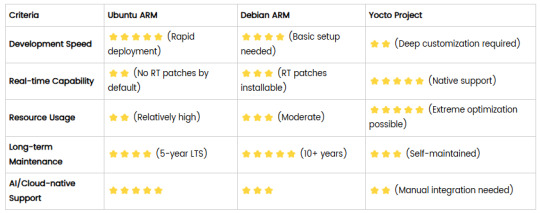
5. Selection Recommendations
Choose Ubuntu ARM: For rapid deployment of edge AI applications (e.g., vision detection on Jetson) or deep integration with public clouds (e.g., AWS IoT Greengrass).
Choose Debian ARM: For mission-critical industrial equipment (e.g., substation monitoring) where stability outweighs feature novelty.
Choose Yocto Project: For custom hardware development (e.g., proprietary industrial boards) or strict real-time/safety certification (e.g., ISO 13849) requirements.
6. Hybrid Architecture Example
Smart factory edge node:
Real-time control layer: RTOS built with Yocto (controlling robotic arms)
Data processing layer: Debian running OPC UA servers
Cloud connectivity layer: Ubuntu Server managing K8s edge clusters
Combining these systems based on specific needs can maximize the efficiency of IIoT edge computing.
0 notes
Text
Top GUI Frameworks and Display Protocols for Embedded Product Development in 2025
In today’s embedded systems, GUIs aren’t just screens — they’re the core of user interaction. Whether you're developing a wearable, an industrial controller, or a smart appliance, creating a seamless graphical user interface (GUI) is critical. This blog explores how to select the right type of LCD touch display, communication protocols, and GUI design tools that align with your product needs.

As a leading board bring-up company, Silicon Signals provides end-to-end board bringup services, with specialization in GUI porting and development using platforms like Qt, LVGL, EmWin, and GTK. Let’s dive into the key components to consider.

Types of LCD Touch Displays
Capacitive Touch Screens
Projected capacitive displays are widely used in consumer electronics like smartphones and tablets. They offer a smooth, responsive multi-touch experience, supporting gestures like pinch-to-zoom and swipe. These displays detect the conductivity of your fingers and perform exceptionally well in dry, clean environments.
Key Benefits:
Multi-touch support
High durability and sleek design
Fast response time
Limitations:
Not ideal for environments where gloves or non-conductive materials are used
Resistive Touch Screens
Resistive displays consist of two layers (plastic and glass) separated by a gap. When pressure is applied, the layers touch, registering the input.
Ideal for: Industrial and rugged environments where gloves or styluses are often used.
Advantages:
Can be operated with any object
Lower cost
Reliable in harsh environments
Drawback:
Requires more pressure, offers less responsiveness than capacitive touch

Display Communication Protocols
Choosing the right communication interface between your display and the processor is crucial for performance and system optimization.
SPI (Serial Peripheral Interface)
SPI is a widely-used protocol in embedded systems, especially when working with lower-resolution screens. It’s simple to implement and works well with basic touch GUIs.
Best suited for: Small displays (~480x360 resolution)
Benefits: Low resource requirements, easy integration on MCUs
Limitation: Not ideal for high-speed or high-res displays
DSI (Digital Serial Interface)
Developed by the MIPI Alliance, DSI is ideal for high-resolution and high-refresh-rate displays with fewer I/O pins required.
Best suited for: Mid-to-high-end embedded systems
Benefits: Power-efficient, scalable, and compatible with modern display controllers
Limitation: Licensing fees due to proprietary technology
HDMI
Used primarily in embedded Linux or high-performance products, HDMI offers the highest quality in terms of audio-visual integration.
Best suited for: Advanced GUIs in medical, aerospace, or industrial systems
Benefits: Combines audio and video, HDCP for secure content, supports large resolutions
Limitation: Requires a more powerful processor and consumes more power

GUI Development Tools & Libraries
Once you've selected your hardware, it’s time to choose a software tool that helps you design and port the GUI effectively. As a board bringup service provider, we at Silicon Signals have deep expertise in GUI porting using Qt, LVGL, EmWin, GTK, and Crank Storyboard.
1. Qt Framework
Qt is a professional-grade development platform used extensively in automotive, medical, and industrial applications.
Language: C++ and QML
Features: Cross-platform, hardware acceleration, built-in protocol support (HTTP, FTP, etc.)
Ideal for: Performance-sensitive, scalable GUIs
Note: Commercial license required for product deployment
We offer advanced Qt porting services for embedded Linux, Yocto-based boards, and RTOS platforms.
2. Crank Storyboard
Storyboard simplifies GUI development with drag-and-drop features, Photoshop imports, and support for animations and 3D elements.
Benefits: Designer-friendly, OS and platform agnostic, embedded engine optimization
Best for: Teams with both design and embedded development backgrounds
Limitation: Requires a license for commercial products
3. LVGL (Light and Versatile Graphics Library)
LVGL is ideal for resource-constrained microcontrollers, with footprint requirements as low as 64kB flash and 8kB RAM.
Languages: C and MicroPython
Platforms: STM32, ESP32, Raspberry Pi, PIC, etc.
GUI Builder: Beta version available
Strengths: Free, open-source, portable
Limitations: Limited for complex UIs or animations
Our team excels in integrating LVGL on custom MCUs and porting it for FreeRTOS and bare-metal systems.
4. EmWin by SEGGER
EmWin is a highly efficient, commercial-grade GUI library optimized for MCUs.
Developed by: SEGGER Microcontroller
Best for: Medical and industrial applications where reliability is non-negotiable
Strength: Real-time performance, minimal resource usage, certified for safety-critical applications
Limitation: Licensing and complexity
We provide EmWin integration services for NXP, STM32, and Renesas-based boards.
5. GTK (GIMP Toolkit)
GTK is a popular GUI library often used in Linux systems and is open-source.
Language: C (bindings available for Python, C++, etc.)
Best for: Embedded Linux systems where scalability and flexibility matter
Drawback: Not suitable for MCUs with limited RAM and Flash
Our engineers can port GTK-based UIs on embedded Linux devices, optimizing for performance and footprint.


Why Silicon Signals?
As a leading board bring-up company, Silicon Signals provides a one-stop solution for embedded product development. From hardware validation and board bringup services to GUI design and porting on popular frameworks like Qt, LVGL, TouchGFX, GTK, and EmWin — we ensure your product is market-ready with a seamless user experience.
Whether you need to develop a medical device UI, a rugged industrial HMI, or a sleek consumer interface, our engineers can help you choose the right display, protocol, and GUI framework.
Ready to design a powerful GUI for your embedded product? Reach out to our engineering team at [email protected] for a free consultation.
#embeddedtechnology#embeddedsoftware#embeddedsystems#linux kernel#androidbsp#linuxdebugging#android#aosp#iot development services#iotsolutions#embeddedgui#guidevelopment#guitools
0 notes
Text
Sr. OpenBMC Firmware Engineer
integration with server platform hardware. – Customize OpenBMC’s Linux distribution using Yocto Project, supporting operations… based on Redfish and IPMI. – Develop, test and deploy server hardware components connected to BMC. – Create and maintain… Apply Now
0 notes
Text
Automotive Embedded Systems and Embedded Training Online
Course Overview:
The Automotive Embedded Systems and Embedded Training Online course offered by Embedded Box provides comprehensive training in the design, development, and implementation of embedded systems tailored specifically for the automotive industry. This course equips students with the knowledge and practical skills required to excel in the rapidly evolving field of automotive electronics and embedded systems.
Course Duration: 6 months
Course Content:
1. Introduction to Automotive Embedded Systems
Overview of automotive embedded systems
Importance of embedded systems in automotive applications
Trends and advancements in automotive electronics
2. Embedded C Programming for Automotive Applications
Introduction to the C programming language
Data types, operators, and expressions
Control structures and functions in C
Memory management and optimization techniques
Debugging and testing techniques for embedded systems
3. Microcontrollers and Microprocessors in Automotive Systems
Introduction to microcontrollers and microprocessors
Architecture and features of popular automotive-grade microcontrollers
Embedded development tools and IDEs
Interfacing peripherals and sensors with microcontrollers
Real-time operating systems (RTOS) for automotive applications
4. Automotive Communication Protocols
CAN (Controller Area Network) protocol fundamentals
LIN (Local Interconnect Network) protocol overview
FlexRay and Ethernet in-vehicle networking
Introduction to automotive diagnostic protocols (OBD-II, UDS)
5. Embedded Software Development Tools
Introduction to Integrated Development Environments (IDEs)
Debugging tools and techniques (emulators, simulators)
Version control systems (Git, SVN) for collaborative development
Code optimization and profiling tools
6. Automotive Embedded Software Design
Software architecture and design principles for automotive systems
Model-Based Design (MBD) using tools like Simulink
Design considerations for safety-critical automotive applications
Implementing automotive standards such as ISO 26262
7. Embedded Linux for Automotive Systems
Introduction to Linux kernel architecture
Customizing and configuring the Linux kernel for embedded systems
Device drivers development and integration
Embedded Linux filesystems and bootloaders
Yocto Project for building custom Linux distributions
8. Hands-on Projects and Case Studies
Design and implementation of automotive embedded systems projects
Integration of sensors, actuators, and communication modules
Real-world automotive system simulations and testing
Case studies on automotive embedded systems applications and challenges
9. Career Development and Industry Insights
Guidance on building a career in automotive embedded systems
Industry trends, job opportunities, and emerging technologies
Interview preparation and resume building workshops
Guest lectures from industry experts and professionals
10. Capstone Project
Final project where students apply their skills to design and develop a complete automotive embedded system
Project presentation and demonstration to showcase proficiency in automotive embedded systems development
Prerequisites:
Basic understanding of programming concepts
Familiarity with electronics and digital circuits
Access to a computer with internet connectivity
Certification:
Upon successful completion of the Automotive Embedded Systems and Embedded Training Online course, students will receive a certificate from Embedded Box, validating their proficiency in automotive embedded systems development.

#embeddedtraining#embeddedcourses#embeddedsystems#embedded training system#embeddedd#embeddedcourse#embeddedsystem#embeddedsysytem#embeddedsystemcourse#embedded
0 notes
Link
0 notes
Text
The Motivation Behind Toradex Embedded Linux BSP 3.x
We recently released our Embedded Linux BSP 3.0 beta, and we would like to provide you some insights into our motivation for the changes and new features in BSP 3.x
The primary reason for the jump from 2.8 directly to 3.0 is that our Embedded Linux BSPs 3.x will no longer be based on the Ångström distribution. We have used the Ångström distribution for many years to provide a simple out-of-the-box experience that includes a desktop environment, to help with initial steps and to simplify development. It was never intended to be directly deployed to volume products.
With the introduction of Torizon, we now provide a superior out-of-the-box experience. Torizon is intended to be directly deployed into final products. It provides the Docker container runtime, offering access to a multitude of userspace and application environments. It also supports Toradex’s tools, such as our Flash Analytics Tool. Torizon even comes with a Debian-based default container that gives you access to thousands of prebuilt packages in a familiar Debian environment, so you can get started fast.

We typically recommend Torizon to customers who are not familiar with the Yocto Project. Experienced Yocto Project developers will find BSP 3.x to be very closely aligned with Poky, the Yocto Project reference distro. Thus, it provides you with an ideal starting point for your own custom Linux build.
This BSP also includes updated bootloaders and kernels. We moved to OpenEmbedded Thud and Yocto Project 2.6.
BSP3.x is supported on Apalis TK1 and all our i.MX-based products. On the Colibri VF50, VF61, T20 and T30, and on the Apalis T30, we will continue maintaining our long-term supported (LTS) BSP 2.8. We will provide updates in the event of hardware changes, and we will regularly fix critical bugs.
You can find more information about long-term support on our developer webpage.
To keep track of updates and get email notifications, we highly recommend subscribing to updates with our new Get Update feature, on the BSP Roadmap Page.
Please note that BSP 3.0 beta 1 was released for the Apalis iMX8QM only. The upcoming BSP 3.0 beta 2 will support all i.MX-based products and the Apalis TK1.
If you have any questions, please don’t hesitate to contact us. You can post in our community forum or contact our technical support teams directly.
0 notes
Text
okay okay okay it's time for the work in progress comprehensive autism special interest list and the ages at which they happened. very much for my own records but like, feel free to read and be like "wtf" if you want. tldr how did nobody pick up the autism
memorised all metric prefixes for every scale of measurement up to / down to yocto and yotta when I was 9 (new prefixes were defined in 2022 yay they are ronna, quetta, ronto, quecto for 10e27, 10e30, 10e-27, 10e-30)
related to above: spent all my free time in year 4 looking at scale of the universe 2
spent all of high school telling everybody about how the time derivatives of position could be extended indefinitely and some of them have cool / stupid names like snap crackle and pop (which I also had memorised in order)
watched every vsauce video before bed every night for like 4 years straight, I must have seen each video at least 150 times by now
related to above: could recite vsauce video scripts and knew exactly what music was playing in the background at any given time in one of his videos
related to above above: made myself cry thinking about Big Theta ™️ in his video on infinity because I was like holy shit inaccessible cardinals are so cool (I still cry every time)
decided I wanted to try an astrophysics project in year 6 because the class projects were too boring, and dedicated a weekend to learning all the required trigonometry (that is, the entire high school trig curriculum)
tried (and failed) to solve navier stokes in year 5, turns out you probably need calculus for that
parents took me (toddler) to an observatory and insisted on paying full price for my ticket because they knew I would ask an absurd amount of questions
decided (as a toddler) I needed to become an astronaut so I could kick pluto back into the solar system
3 notes
·
View notes
Photo

100 Favorite Idol Songs of 2019
(via Medium)
One of the most exciting developments of the idol scene this decade has been the evolution of what an idol song can sound like. Many groups have brought their own idol-pop take on metal, punk, rap, trance, emo, math rock, jazz, shoegaze — or multiple of these genres at once. Dance-pop idols expanded their list of influences too, borrowing from retro styles like city pop and disco but also current trends like future-bass. All the while, the twinkling synths and strings of more traditional groups have yet to wane in popularity.
That genre dive, however, has also become the norm. A strategy of juxtaposition no longer feels impressive with so many combinations of personality and sound that have already been done. An interesting sound won’t necessarily guarantee a long run of success either. A group still needs the tried-and-true idol-group foundations of a drawing narrative and a line-up of likeable members.
That’s if they want to stick around for long. Many acts will continue to be a flash in the pan, and that’s fine: I still think idol groups aren’t designed to last a decade, or even half of that time, and it takes a lot of resources, perseverance and luck to go on for even half of that time. But this decade, we’ve also seen the lifespan of an act grow a little longer. It has not necessarily become easier to navigate — in fact, it might be even harder now with so many around — but the scene has proven to be more established with more potential markets if you can get a little creative.
Adapting to change and tracking that growth has been a key element to idols this decade. Following the evolution of the group’s music has been exciting, but also witnessing individual idols find their own identity in real time has been the most rewarding. This won’t change going into the next decade, and perhaps more crucial, especially as it becomes harder to introduce a sense of novelty: it’s going to be more important to convince others to follow the ride than try to be the next big thing right away.
I wonder what next thing will sound or look like in the coming years as we go forward to a new decade. Will idols need to be a jack of all trades, a master of a different style from single to single? Will they include a multimedia facet to their work, so a song also feels like a video and a live show all at once? Or will their stubbornness to buy into this everything-at-once vision bring a new lane where strictly following a single style has been the right choice all along? It can go any way, and some groups in this list hint at each possibility.
You can check out my 100 favorite idol songs of 2019 over at Medium. Here is a Spotify playlist and a YouTube playlist of the 100 (or what is available). If you want the full YouTube archive of every single I kept tabs on, here it is as well. Below is a text list of the feature piece. Hope you find something new!
1. BiSH: "I am me." 2. Dempagumi.Inc: "Taiyoukei Kansatsuchuu Seimeitai" 3. GuGu-Lulu: "Picked" 4. Atarashii Gakkou No Leaders: "Koi Geba" 5. The Dance for Philosophy: "Hueristic City" 6. Angerme: "Yume Mita Fifteen" 7. Shiritsu Ebisu Chugaku: "Donten" 8. Lyrical School: "Tokyo Burning" 9. Hinatazaka46: "Kyun" 10. Burst Girl: "Nancy" 11. Necronomidol: "Salem" 12. Migma Shelter: "69" 13. BEYOOOONDS: "Nippon No DNA" 14. M!LK: "My Treasure" 15. Juice=Juice: "Potsurito" 16. Maison Book Girl: "Yamiiro No Asa" 17. Keyakizaka48: "Nobody" 18. Kai: "Moonlight Tokyo" 19. EMPiRE: "Pierce" 20. AKB48/Rino Sashihara: "Watashidatte Idol!" 21. Passcode: "Projection" 22. Sakura Ebis: "Nee, Loafer" 23. Yufu Terashima: "Last Cinderella" 24. ZOC: "Chu Pre" 25. Sora Tob Sakana: "Knock! Knock!" 26. CY8ER: "Spotlight Theory" 27. Yukueshirezu Tsure Zure: "Odd Eye" 28. Zenbu Kimi No Seida: "Romancesect" 29. Gang Parade: "Last" 30. Koutei Camera Girl Drei: "Changes" 31. Flower: "Kurenai No Dress" 32. Super Dragon: "Don't Let Me Down" 33. Mellow Mellow: "Dear My Star" 34. Tsubaki Factory: "Sankaime No Date Shinwa" 35. E-girls: "Cinderella Fit" 36. Yanakoto Sotto Mute: "Cry Out" 37. Morning Musume '19: "Seishun Night" 38. NMB48: "Yakebokkui" 39. Ototoy Friday: "Spring Fever" 40. Negicco: "I Love Your Love" 41. Rukatama A Go Go: "Runaway Girl" 42. Kaede: "Kaede No Enkyori Renai" 43. Gunjo No Sekai: "Nonstop" 44. CYNHN: "Wire" 45. Emiri Kanou: "Just a Feeling" 46. Carry Loose: "Carry Loose" 47. RAY: "Butterfly Effect" 48. Blacknazarene: "Obsidian" 49. Toricago: "Kuchibashi" 50. Kamiyado: "Zenshin Zenrei Rhapsody" 51. Hamidasystem: “Sonzai Shinai Zonzai Na Ai” 52. Momoiro Clover Z: “The Diamond Four” 53. Team Shachi (ft. MCU): “Rocket Queen” 54. Kindan No Tasuketsu: “Flashing Light -Neubaten Time-” 55. Uijin: “Gold” 56. RYUTist: “Never Let Me Back” 57. Nogizaka46: “Yoakemade Tsuyogaranakutemoii” 58. Sayonara Ponytail: “Sora Tobu Koguma, Junreisu” 59. Jewel: “Mae-e” 60. One Chance: “I Want You Back” 61. Billie Idle: “Bokura Mada Chipokkena Koro No Hanashi” 62. Melon Batake A Go Go: “Ikasuze Idol” 63. Ringo Musume: “Kimi Dake” 64. Qumali Depart: “Goku Love Jodo” 65. Tiptoe.: “The Curtain Rises” 66. DISH//: “Henteko” 67. Transfer Girls: “Catch Me (If You Can)” 68. Kyushuu Girls Wing: “Flow of Red” 69. Geiin Wa Jibun Ni Aru: “Geiin Wa Jibun Ni Aru” 70. Shuu Cream Rockets: “Akuma No Deal” 71. WILL-O’: “Sparking” 72. Tacoyaki Rainbow: “Watashi, Tada Koi Wo Shiteiru” 73. Monster Girlfriend: “GAM” 74. WHY@DOLL: “Que Sera, Sera” 75. PRIZMAX: “Dance” 76. Colorful Scream: “Innocent Galileo” 77. Oyasumi Hologram: “Plan” 78. SKE48: “Frustration” 79. Gomaten: “Kakurekko” 80. The Banana Monkeys: “How Many Times Honesty” 81. Hitomi Arai: “Delicate Ni Sukinishite” 82. Happy3days: “Walk On” 83. IDOLATER: “Swipin’ Flickin’” 84. Farewell, My L.U.V.: “Gloomy Girl” 85. =LOVE: “Zuruiyo, Zuruine” 86. Bullet Train: “On & On” 87. CUBERS: “Mousou Romance” 88. Mushuuuuup!!!: “Tsukai Refrain” 89. OBP: “Progress” 90. Flowlight: “Flower” 91. Watashi Mugendai: “Neo Anarchism” 92. Pure White Canvas: “Persavior” 93. Run Girls, Run!: “Share the Light” 94. Earphones: “Churata Churaha” 95. Bury: "Break Your Wall" 96. Seireki13ya: “Yocto Asterism” 97. Q-pitch: “Nanikashiyou” 98. NILKLY: “Odyssey” 99. Tokimeki Sendenbu: “Koi No Shapeup” 100. Hashiyasume Atsuko: “A La Mode”
5 notes
·
View notes
Link
Yocto Project was introduced to help Embedded Linux Developers overcome the challenges created by the discreet build systems of a fragmented Linux OS distribution ecosystem. This blog is a introspection of technology that has enabled Yocto Project to effectively address these challenges.For More Visit:https://www.embitel.com/blog/embedded-blog/why-yocto-is-a-framework-of-choice-for-creation-of-embedded-linux-distributions
0 notes
Link
0 notes
Text
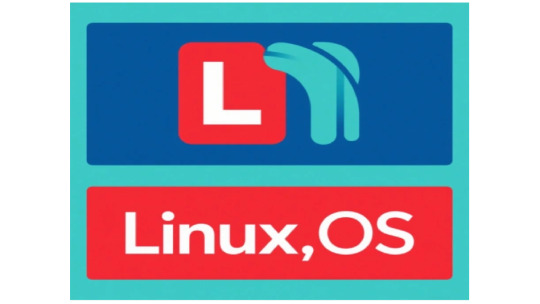
Comparison of Ubuntu, Debian, and Yocto for IIoT and Edge Computing
In industrial IoT (IIoT) and edge computing scenarios, Ubuntu, Debian, and Yocto Project each have unique advantages. Below is a detailed comparison and recommendations for these three systems:
1. Ubuntu (ARM)
Advantages
Ready-to-use: Provides official ARM images (e.g., Ubuntu Server 22.04 LTS) supporting hardware like Raspberry Pi and NVIDIA Jetson, requiring no complex configuration.
Cloud-native support: Built-in tools like MicroK8s, Docker, and Kubernetes, ideal for edge-cloud collaboration.
Long-term support (LTS): 5 years of security updates, meeting industrial stability requirements.
Rich software ecosystem: Access to AI/ML tools (e.g., TensorFlow Lite) and databases (e.g., PostgreSQL ARM-optimized) via APT and Snap Store.
Use Cases
Rapid prototyping: Quick deployment of Python/Node.js applications on edge gateways.
AI edge inference: Running computer vision models (e.g., ROS 2 + Ubuntu) on Jetson devices.
Lightweight K8s clusters: Edge nodes managed by MicroK8s.
Limitations
Higher resource usage (minimum ~512MB RAM), unsuitable for ultra-low-power devices.
2. Debian (ARM)
Advantages
Exceptional stability: Packages undergo rigorous testing, ideal for 24/7 industrial operation.
Lightweight: Minimal installation requires only 128MB RAM; GUI-free versions available.
Long-term support: Up to 10+ years of security updates via Debian LTS (with commercial support).
Hardware compatibility: Supports older or niche ARM chips (e.g., TI Sitara series).
Use Cases
Industrial controllers: PLCs, HMIs, and other devices requiring deterministic responses.
Network edge devices: Firewalls, protocol gateways (e.g., Modbus-to-MQTT).
Critical systems (medical/transport): Compliance with IEC 62304/DO-178C certifications.
Limitations
Older software versions (e.g., default GCC version); newer features require backports.
3. Yocto Project
Advantages
Full customization: Tailor everything from kernel to user space, generating minimal images (<50MB possible).
Real-time extensions: Supports Xenomai/Preempt-RT patches for μs-level latency.
Cross-platform portability: Single recipe set adapts to multiple hardware platforms (e.g., NXP i.MX6 → i.MX8).
Security design: Built-in industrial-grade features like SELinux and dm-verity.
Use Cases
Custom industrial devices: Requires specific kernel configurations or proprietary drivers (e.g., CAN-FD bus support).
High real-time systems: Robotic motion control, CNC machines.
Resource-constrained terminals: Sensor nodes running lightweight stacks (e.g., Zephyr+FreeRTOS hybrid deployment).
Limitations
Steep learning curve (BitBake syntax required); longer development cycles.
4. Comparison Summary
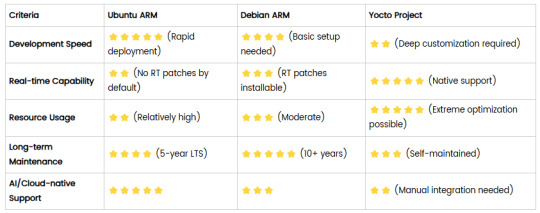
5. Selection Recommendations
Choose Ubuntu ARM: For rapid deployment of edge AI applications (e.g., vision detection on Jetson) or deep integration with public clouds (e.g., AWS IoT Greengrass).
Choose Debian ARM: For mission-critical industrial equipment (e.g., substation monitoring) where stability outweighs feature novelty.
Choose Yocto Project: For custom hardware development (e.g., proprietary industrial boards) or strict real-time/safety certification (e.g., ISO 13849) requirements.
6. Hybrid Architecture Example
Smart factory edge node:
Real-time control layer: RTOS built with Yocto (controlling robotic arms)
Data processing layer: Debian running OPC UA servers
Cloud connectivity layer: Ubuntu Server managing K8s edge clusters
Combining these systems based on specific needs can maximize the efficiency of IIoT edge computing.
0 notes
Text
Understanding the 4 Core Components of an Embedded Linux System
Before diving into how to build a complete embedded Linux system, it’s important to know what major parts make up the system itself. A good way to understand this is by looking at the boot process — what happens when you power on a device like an embedded controller, industrial gateway, or smart gadget.
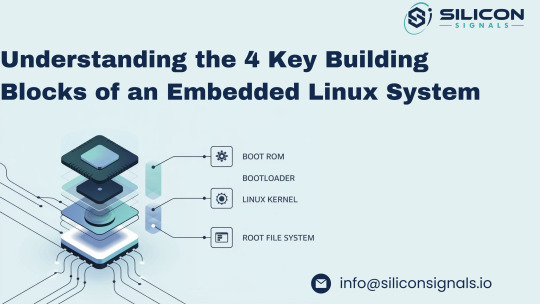
Each component plays a specific role in bringing the system to life, step by step. Here's a simple breakdown of the four essential parts of an embedded Linux system:
1. 🧠 Boot ROM – The Starting Point Inside the SoC
The Boot ROM is the very first code that runs when you power on your embedded device. It’s stored in read-only memory directly inside the System-on-Chip (SoC) and is similar to the BIOS on a standard computer. Although it's locked and can't be changed, it can react to external configurations (like boot pins) to decide where to load the next stage from – such as an SD card, eMMC, NAND flash, or even over UART/serial.
Some Boot ROMs also support secure boot by only allowing signed software to load next, adding a strong layer of security to the embedded system.
2. 🚀 Bootloader – Initializing the Hardware and Loading the Kernel
After the Boot ROM finishes its job, it passes control to the Bootloader. In many cases, the bootloader itself runs in two steps:
First stage: Prepares the system by initializing the RAM (since it's not ready right after power-up).
Second stage: Loads the Linux kernel from a chosen storage device or over a network (useful during development via TFTP).
Modern bootloaders also include features to:
Flash firmware or kernels onto memory devices like NAND or eMMC,
Test hardware components like I2C/SPI, RAM, and others,
Run Power-On Self-Tests (POST) to ensure system stability before launching the OS.
Popular bootloaders like U-Boot are often used in embedded Linux development for their flexibility and wide hardware support.
3. 🧩 Linux Kernel – The Core of the Operating System
The Linux Kernel is the brain of the system and is responsible for:
Talking to the hardware (drivers for peripherals),
Handling system tasks like scheduling and memory management,
Creating a stable environment for your applications to run.
It acts as the bridge between the hardware layer and the user space, making it possible to develop portable embedded applications that don’t rely on the specifics of the underlying board.
4. 📁 Root File System – The Application Playground
Once the kernel is up and running, its next task is to mount the root file system — the place where all applications, scripts, and shared libraries live.
Creating this from scratch is complex due to package dependencies and compatibility issues. That’s why tools like Buildroot, Yocto Project, or OpenEmbedded are used to automatically build and manage the root filesystem.
These tools help embedded developers customize and maintain a lightweight and reliable file system tailored to their device, ensuring consistency and performance.
Need Help Building Your Embedded Linux Solution?
At Silicon Signals, we specialize in custom embedded Linux development, including board bring-up, device driver integration, Android BSPs, secure boot implementation, and real-time optimizations.
Whether you're working on a new product or looking to optimize an existing one, our team can help you accelerate development and reduce risk.
📩 Contact us today to discuss how we can bring your embedded system to life. 🌐 Visit: www.siliconsignals.io ✉️ Email: [email protected]
#embeddedtechnology#embeddedsoftware#embeddedsystems#linux kernel#linuxdebugging#iot development services#iotsolutions
0 notes
Text
Easily Add Cellular Connectivity to Your TPS-Based Products
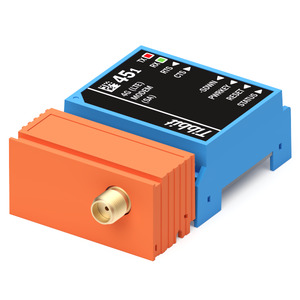
The ubiquity of smartphones and other connected devices means that there is cellular coverage nearly everywhere, particularly in industrial and business areas. This makes cellular connectivity ideal for Internet of Things applications: It provides reliable Internet access without requiring the infrastructure and cost of Ethernet or Wi-Fi networks.
The Tibbo Project System (TPS) currently features not one, but two modules that implement cellular connections: 4G (LTE) modem Tibbit #45 and Cat-M1/NB-IoT modem Tibbit #46. Use either to liberate your TPS-based products from the shackles of wired networks or as a backup connection for mission-critical applications.
The modular nature of the TPS platform means that adding and configuring a cellular modem Tibbit can take as little as a few minutes. The video below demonstrates how to configure Tibbit #45 on our Size 3 Linux Tibbo Project PCB (LTPP3), Gen. 2 running Tibbo's Yocto-based distribution.
youtube
Tibbo also supplies the libraries to facilitate configuring the cellular modem Tibbits on our Ubuntu-based distribution for the LTPP3(G2) and TiOS-based boards, such as the Size 2 Tibbo Project PCB (TPP2), Gen. 2 and the Size 3 Tibbo Project PCB (TPP3), Gen. 2.
0 notes
Link
0 notes
Link
0 notes
Text
Introducing Torizon: An Easy-to-use Industrial Linux Platform

Torizon is a brand-new open-source software platform from Toradex that aims to simplify the development and maintenance of embedded Linux Software. Torizon is built on top of a minimal Linux-based, Yocto-compatible Operating System. Torizon comes with built-in support for Docker containers and over-the-air (OTA) updates. It integrates with Visual Studio and Qt, and provides a variety of tools and features to simplify the life of developers.
Key Takeaways:
What is Torizon? Why should you adopt it?
Docker/ Software Containers Introduction
See the out-of-the-box experience
Learn about the over-the-air (OTA) updates using OSTree and Aktualizr
Experience the Microsoft Embedded Developer Environment
Learn how to leverage the Torizon tools, such as Flash Analytics
Grab your free registrations now: https://www.toradex.com/webinars/introducing-torizon-easy-to-use-industrial-linux-platform
Date and Time:
Europe/Asia - Friday, June 07, 2019, 2019 10:00 AM - 11:00 AM (CET)
Americas - Friday, June 07, 2019, 2019 10:00 AM - 11:00 AM (PDT)
Speakers:
Daniel Lang, CMO, Toradex
Valter Minute, Sr. Development Engineer, Toradex
Venue: Online Webinar
0 notes